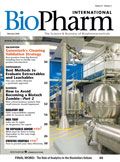The Role of Analytical Science in the Debate over Biosimilars
Both innovator and generics companies are using analytics to support comparability arguments.
As the US biopharmaceutical industry and regulators debate new requirements for biosimilars, industry leaders are already turning to analytical science to define intellectual property and business development strategies. Emerging techniques are providing previously unseen protein characterization details in turn giving both innovators and generics new weapons in the battle for future market share.

Jeffrey R. Mazzeo
The impact of generic small-molecule medicines on the pharmaceutical industry is well documented. The current debate over large-molecule generics therefore is no surprise.
Currently, there is no regulatory pathway for generic versions of biopharmaceutical drugs in the US market. However, history shows the US Food and Drug Administration (FDA) has embraced biopharmaceutical policy change guided or even driven by new analytical techniques. In 1996, the FDA promulgated the concept of the well-characterized biologic product (WCBP), which acknowledged that analytical techniques could definitively determine a biologic product's identity, purity, potency, and stability. This statement allowed the agency to approve biologic products, compared to the previous requirements, which permitted approval of the biologic manufacturing process.
An outcome of the WCBP concept was that companies could use comparability protocols to support manufacturing changes (improve yield, add manufacturing capacity, etc.) without additional clinical testing. Comparability protocols ensure that the product manufactured with a new process is similar to the product of the original process. This component to WCBP opened the door to the argument that because innovator companies use comparability protocols to support manufacturing changes, the same analytical approach could be a pathway to new biosimilar product approvals.
With an additional 10 years of analytical science innovation since the WCBP concept was first publicized, how far away can we be from new FDA biosimilar policies?
Today, new techniques for studying higher-order protein structure are emerging that provide rapid and accurate therapeutic protein batch comparisons. Higher-order structure is a critical quality attribute of a biopharmaceutical protein. Slight changes in these structures can dramatically impact the safety and efficacy of a given molecule. Unfortunately, today's methods for determining higher-order structure can require days of analysis—but this is changing. For example, ion mobility spectrometry coupled with mass spectrometry shows great promise for determining differences in high-order structure in just minutes of analysis time.1 This methodology could be used to rapidly demonstrate that every batch of a given protein has the same higher-order structure as the reference batch.
Another example is analysis of glycosylation, which plays a critical role in the safety and efficacy of many therapeutic proteins. Heterogeneity resulting from differences in glycosylation is difficult to measure because of its tremendous complexity. New methods that integrate specific enzymes, advanced analytical techniques, and mathematical modes can provide much more detailed analysis of glycosylation heterogeneity.2
Both innovator and generics companies are quickly adopting these kinds of techniques, but with very different business objectives in mind. Innovator companies are depending on analytics to demonstrate the inherent complexities of their products. Their goal is to protect patents by fingerprinting biologics to the extent that they cannot be exactly copied, thus making a match of the approved biologic unachievable. However, the risk in such a strategy lies in the innovator's capacity to reproducibly manufacture the same fingerprint. A careful balance between differentiation and manufacturability must be weighed.
Generics companies are maximizing analytical science to fully characterize proteins to show equivalency and structural comparability. Demonstration of structural comparability potentially means avoiding the need for extensive clinical trials comparing the biosimilar product to the innovator product. Minimizing the need for extensive clinical trials is important for generics companies to keep development costs low, so that pricing advantages can be sustained. The risk in this strategy is that, as more powerful tools are used to compare the biosimilar to the innovator drug, at some point differences must be found.
Analytics have played a key role in moving the biopharmaceutical industry forward and will continue to play a central role in the ongoing biosimilar debate. Both innovator biopharmaceutical companies and biosimilar developers must align their business strategies with the best available analytical technology for characterizing protein therapeutics. For the biopharmaceutical industry, good science means good business.
Jeffrey R. Mazzeo, is the biopharmaceutical business director at Waters Corporation, Milford, MA, 508.482.3462, jeff_mazzeo@waters.com.
REFERENCES
1. Smith, D, et al. J Am Soc Mass Spectrom. 2007(18):2180–2190.
2. Cormac Sheridan. Commercial interest grows in glycan analysis. Nature Biotechnol. 2007;25(2):145–146.

MHRA Approves GSK Therapy Combinations for Multiple Myeloma
April 21st 2025Belantamab mafodotin is approved in combination with bortezomib plus dexamethasone in patients who have had at least one prior therapy, and in combination with pomalidomide plus dexamethasone for those who have had a prior therapy including lenalidomide.
Teva and Samsung Bioepis Launch Biosimilar Eculizumab in US Market
April 17th 2025Eculizumab-aagh (EPYSQLI) is now available in the US to treat patients living with difficult-to-treat rare diseases such as paroxysmal nocturnal hemoglobinuria, atypical hemolytic uremic syndrome, and generalized myasthenia gravis.